非谓语经典总结
- 格式:doc
- 大小:39.50 KB
- 文档页数:2
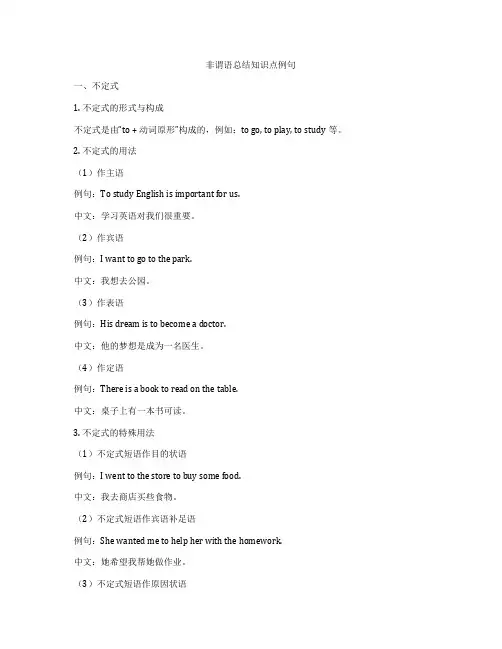
非谓语总结知识点例句一、不定式1. 不定式的形式与构成不定式是由“to + 动词原形”构成的,例如:to go, to play, to study等。
2. 不定式的用法(1)作主语例句:To study English is important for us.中文:学习英语对我们很重要。
(2)作宾语例句:I want to go to the park.中文:我想去公园。
(3)作表语例句:His dream is to become a doctor.中文:他的梦想是成为一名医生。
(4)作定语例句:There is a book to read on the table.中文:桌子上有一本书可读。
3. 不定式的特殊用法(1)不定式短语作目的状语例句:I went to the store to buy some food.中文:我去商店买些食物。
(2)不定式短语作宾语补足语例句:She wanted me to help her with the homework.中文:她希望我帮她做作业。
(3)不定式短语作原因状语例句:He came early to catch the first bus.中文:他早点来是为了赶第一班车。
二、动名词1. 动名词的形式与构成动名词是由动词加上-ing构成的,例如:going, playing, studying等。
2. 动名词的用法(1)作主语例句:Studying hard is necessary for passing the exam.中文:努力学习对通过考试是必要的。
(2)作宾语例句:I enjoy singing in the shower.中文:我喜欢在淋浴时唱歌。
(3)作定语例句:I have a lot of work to do.中文:我有很多工作要做。
3. 动名词的特殊用法(1)动名词短语作主语例句:Swimming is good for your health.中文:游泳对你的健康有好处。
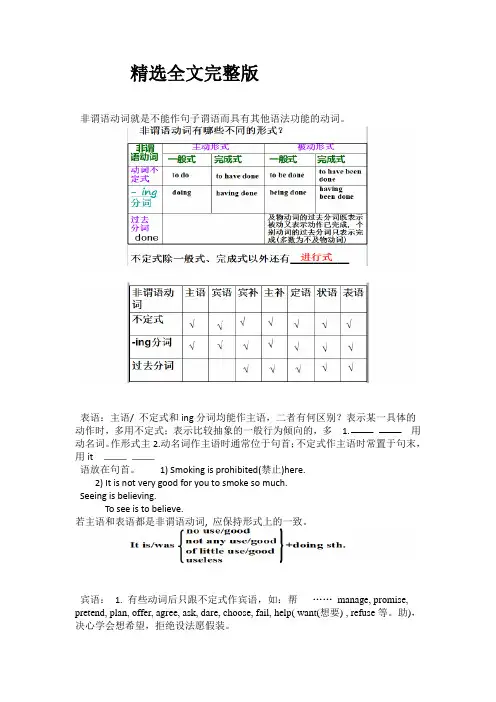
精选全文完整版非谓语动词就是不能作句子谓语而具有其他语法功能的动词。
表语:主语/ 不定式和ing分词均能作主语,二者有何区别?表示某一具体的动作时,多用不定式;表示比较抽象的一般行为倾向的,多 1.用动名词。
作形式主2.动名词作主语时通常位于句首;不定式作主语时常置于句末,用it语放在句首。
1) Smoking is prohibited(禁止)here.2) It is not very good for you to smoke so much.Seeing is believing.To see is to believe.若主语和表语都是非谓语动词, 应保持形式上的一致。
宾语:1. 有些动词后只跟不定式作宾语,如:帮……manage, promise, pretend, plan, offer, agree, ask, dare, choose, fail, help(want(想要) , refuse等。
助),决心学会想希望,拒绝设法愿假装。
主动答应选计划,同意请求帮一帮。
2. 有些动词后只跟动名词作宾语,如:practise, appreciate, dislike, excuse, forgive, keep, resist, risk, deny, advise,fancy, ……complete, forbid, permit, allow, stand, refer to, give up, lead to, take to, set about, getdown to, object to, succeed in, have difficulty in... 考虑建议盼原谅,承认推迟没得想。
避免错过继续练,否认完成就欣赏。
禁止想象才冒险,不禁介意准逃亡。
分后既可以跟不定式又可以跟ing3.有些动词如begin, start; love, like, hate, prefer 不定式表示具分词一般表示经常性的行为;词作宾语,意义上无多大区别(但ing。
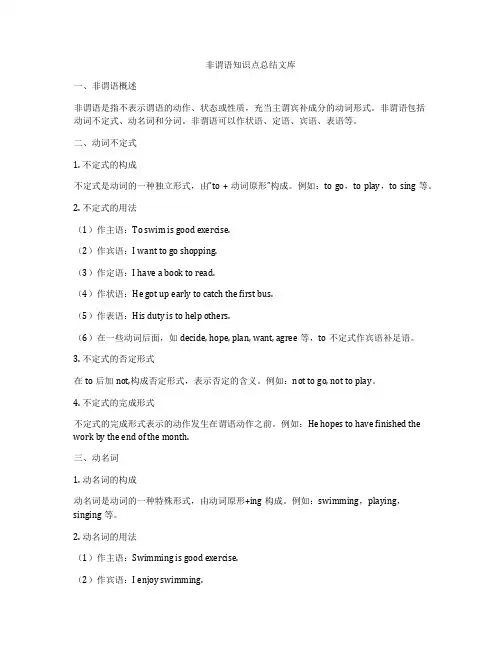
非谓语知识点总结文库一、非谓语概述非谓语是指不表示谓语的动作、状态或性质,充当主谓宾补成分的动词形式。
非谓语包括动词不定式、动名词和分词。
非谓语可以作状语、定语、宾语、表语等。
二、动词不定式1. 不定式的构成不定式是动词的一种独立形式,由“to + 动词原形”构成。
例如:to go,to play,to sing等。
2. 不定式的用法(1)作主语:To swim is good exercise.(2)作宾语:I want to go shopping.(3)作定语:I have a book to read.(4)作状语:He got up early to catch the first bus.(5)作表语:His duty is to help others.(6)在一些动词后面,如decide, hope, plan, want, agree等,to不定式作宾语补足语。
3. 不定式的否定形式在to后加not,构成否定形式,表示否定的含义。
例如:not to go, not to play。
4. 不定式的完成形式不定式的完成形式表示的动作发生在谓语动作之前。
例如:He hopes to have finished the work by the end of the month.三、动名词1. 动名词的构成动名词是动词的一种特殊形式,由动词原形+ing构成。
例如:swimming,playing,singing等。
2. 动名词的用法(1)作主语:Swimming is good exercise.(2)作宾语:I enjoy swimming.(3)作定语:I have a swimming pool.(4)作状语:She left after finishing her homework.3. 动名词的否定形式在动名词前加not来构成否定形式。
例如:not swimming, not playing。
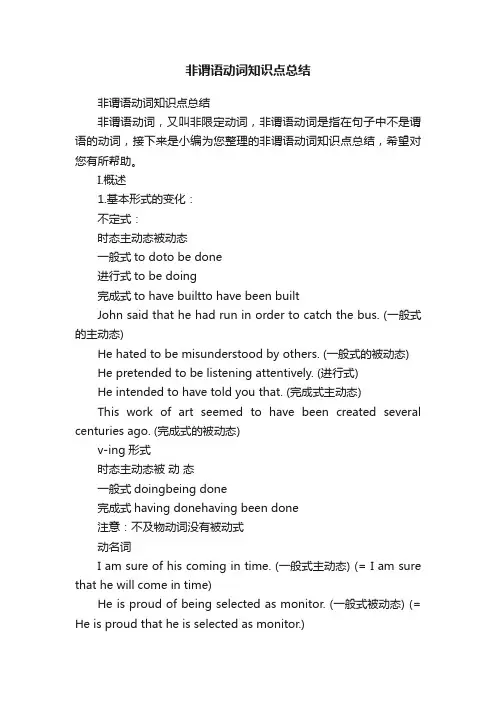
非谓语动词知识点总结非谓语动词知识点总结非谓语动词,又叫非限定动词,非谓语动词是指在句子中不是谓语的动词,接下来是小编为您整理的非谓语动词知识点总结,希望对您有所帮助。
I.概述1.基本形式的变化:不定式:时态主动态被动态一般式to doto be done进行式to be doing完成式to have builtto have been builtJohn said that he had run in order to catch the bus. (一般式的主动态)He hated to be misunderstood by others. (一般式的被动态) He pretended to be listening attentively. (进行式)He intended to have told you that. (完成式主动态)This work of art seemed to have been created several centuries ago. (完成式的被动态)v-ing形式时态主动态被动态一般式doingbeing done完成式having donehaving been done注意:不及物动词没有被动式动名词I am sure of his coming in time. (一般式主动态) (= I am sure that he will come in time)He is proud of being selected as monitor. (一般式被动态) (= He is proud that he is selected as monitor.)I’m confident of his having passed the exam. (完成式主动态) (= I am confident that he have passed the exam.)He complained of having been cheated by others. (完成式被动态)现在分词He sat in a chair,reading a novel. (一般式主动态)Being exhausted by work, he fell asleep quickly. (一般式被动态)Having finished his homework, he went playing. (完成式主动态)All this having been settled, he went home. (完成式被动态)2.所做成分项目/成分主语表语宾语宾补定语状语动词的ing形式现在分词△ △△△动名词△△△ △不定式△△△△△△过去分词△ △△△注:现在分词、不定式、过去分词都可以作独立成分。
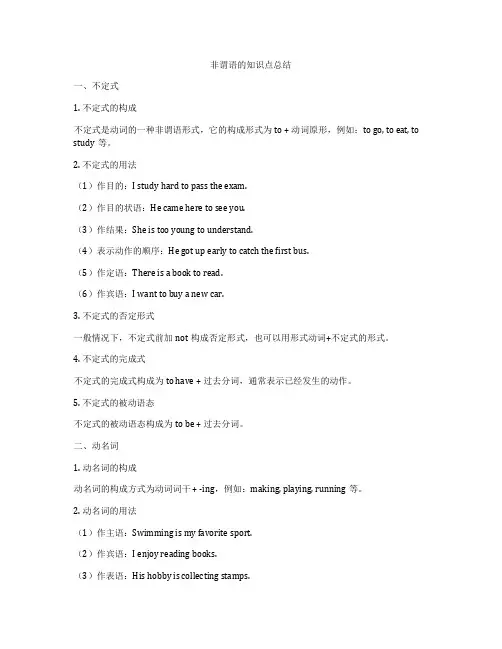
非谓语的知识点总结一、不定式1. 不定式的构成不定式是动词的一种非谓语形式,它的构成形式为to + 动词原形,例如:to go, to eat, to study等。
2. 不定式的用法(1)作目的:I study hard to pass the exam.(2)作目的状语:He came here to see you.(3)作结果:She is too young to understand.(4)表示动作的顺序:He got up early to catch the first bus.(5)作定语:There is a book to read.(6)作宾语:I want to buy a new car.3. 不定式的否定形式一般情况下,不定式前加not构成否定形式,也可以用形式动词+不定式的形式。
4. 不定式的完成式不定式的完成式构成为to have + 过去分词,通常表示已经发生的动作。
5. 不定式的被动语态不定式的被动语态构成为to be + 过去分词。
二、动名词1. 动名词的构成动名词的构成方式为动词词干 + -ing,例如:making, playing, running等。
2. 动名词的用法(1)作主语:Swimming is my favorite sport.(2)作宾语:I enjoy reading books.(3)作表语:His hobby is collecting stamps.(4)作介词宾语:I am tired of waiting.(5)动名词的所有格形式:I remember her reading my letter.3. 动名词的否定形式一般情况下,动名词前加not构成否定形式。
4. 动名词的复合结构动名词能够和其他词语组成复合结构,例如:doing well, running fast等。
5. 句子中的动名词短语动名词短语是指由动名词构成的短语,在句子中起到名词的作用。
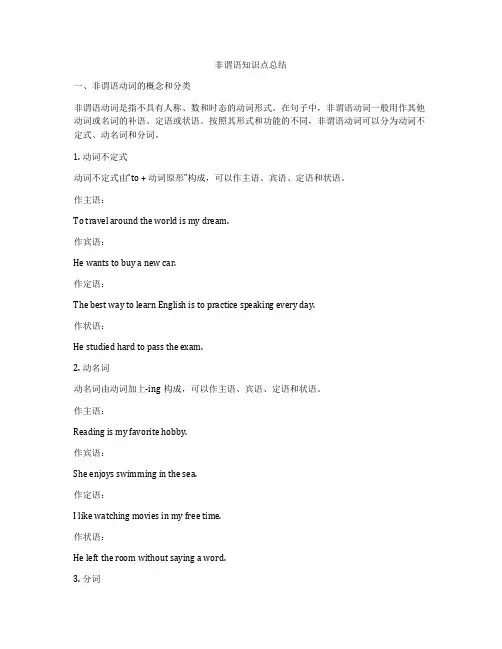
非谓语知识点总结一、非谓语动词的概念和分类非谓语动词是指不具有人称、数和时态的动词形式。
在句子中,非谓语动词一般用作其他动词或名词的补语、定语或状语。
按照其形式和功能的不同,非谓语动词可以分为动词不定式、动名词和分词。
1. 动词不定式动词不定式由“to + 动词原形”构成,可以作主语、宾语、定语和状语。
作主语:To travel around the world is my dream.作宾语:He wants to buy a new car.作定语:The best way to learn English is to practice speaking every day.作状语:He studied hard to pass the exam.2. 动名词动名词由动词加上-ing构成,可以作主语、宾语、定语和状语。
作主语:Reading is my favorite hobby.作宾语:She enjoys swimming in the sea.作定语:I like watching movies in my free time.作状语:He left the room without saying a word.3. 分词分词有现在分词和过去分词两种形式,现在分词一般以-ing结尾,过去分词一般以-ed、en、t结尾,可以作定语、状语和补语。
现在分词作定语:The girl standing by the door is my sister.现在分词作状语:She came home, feeling tired and hungry.过去分词作定语:The film directed by him won the best picture award.过去分词作补语:I was surprised to see the door closed.二、非谓语动词的用法1. 动词不定式(1)作主语To leave now is the best decision.(2)作宾语I want to learn English well.(3)作定语I have a book to read.(4)作状语He works hard to support his family.2. 动名词(1)作主语Swimming is good for health.(2)作宾语I enjoy reading books in my free time.(3)作定语The boy standing there is my brother.(4)作状语He goes to the gym every day, practicing yoga.3. 分词(1)现在分词作定语The girl sitting next to me is my best friend.(2)现在分词作状语Smiling happily, she accepted the gift.(3)过去分词作定语The meal cooked by my mother tastes delicious.(4)过去分词作补语I was excited to hear the news announced by the principal.三、非谓语动词形式的转换1. 从动词不定式到动名词动词不定式to do可以变为动名词doing,例如:I like to swim.(动词不定式)I like swimming.(动名词)2. 从动名词到动词不定式动名词doing可以变为动词不定式to do,例如:We enjoyed singing together.(动名词)We enjoyed to sing together.(动词不定式)3. 从动词不定式到分词动词不定式to do可以变为现在分词doing和过去分词done,例如:He is busy with his work.(动词不定式)He is busy doing his work.(现在分词)He is busy done his work.(过去分词)四、非谓语动词的特殊用法1. 不定式的被动语态动词不定式的被动语态结构为“to be + 过去分词”,例如:He is said to be a good student.2. 动名词的所有格形式动名词的所有格形式是在动名词后面直接加上“的”,例如:I remember his coming to see me.3. 分词作状语表示时间、原因、条件和方式现在分词和过去分词作状语表示时间、原因、条件和方式,例如:Being an experienced teacher, she knows how to deal with children. Having finished her homework, she went to bed.4. 动词不定式作目的状语动词不定式作目的状语表示目的或结果,通常放在句子后面,例如:He ran fast to catch the bus.五、非谓语动词的练习1. 单项选择题(1)We should encourage the students ____ more exercise every day.A. doB. to doC. doingD. are doing(2)I enjoy _____ in the garden in my free time.A. to workB. workingC. worksD. worked(3)The news _____ by the teacher surprised everyone.A. announceB. announcingC. announcedD. to announce2. 填空练习(1)_____ up early in the morning, she went for a run.(2)He wants _____ to the school team next year.(3)She likes _____ to music in her room.3. 句子翻译(1)他想去看电影。
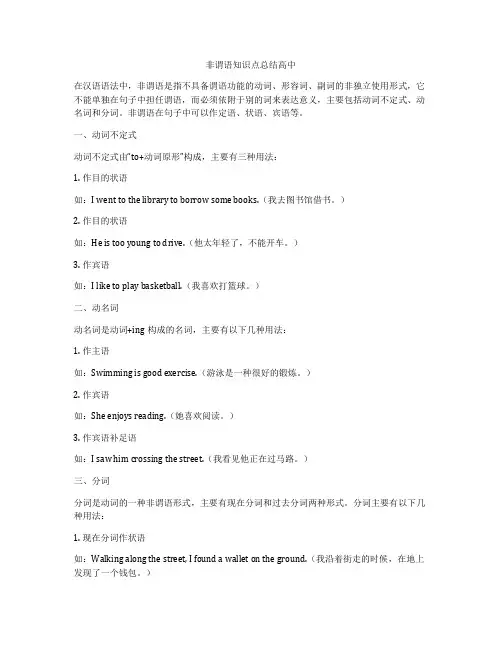
非谓语知识点总结高中在汉语语法中,非谓语是指不具备谓语功能的动词、形容词、副词的非独立使用形式,它不能单独在句子中担任谓语,而必须依附于别的词来表达意义,主要包括动词不定式、动名词和分词。
非谓语在句子中可以作定语、状语、宾语等。
一、动词不定式动词不定式由“to+动词原形”构成,主要有三种用法:1. 作目的状语如:I went to the library to borrow some books.(我去图书馆借书。
)2. 作目的状语如:He is too young to drive.(他太年轻了,不能开车。
)3. 作宾语如:I like to play basketball.(我喜欢打篮球。
)二、动名词动名词是动词+ing构成的名词,主要有以下几种用法:1. 作主语如:Swimming is good exercise.(游泳是一种很好的锻炼。
)2. 作宾语如:She enjoys reading.(她喜欢阅读。
)3. 作宾语补足语如:I saw him crossing the street.(我看见他正在过马路。
)三、分词分词是动词的一种非谓语形式,主要有现在分词和过去分词两种形式。
分词主要有以下几种用法:1. 现在分词作状语如:Walking along the street, I found a wallet on the ground.(我沿着街走的时候,在地上发现了一个钱包。
)2. 现在分词作状语如:He heard a girl singing.(他听见一个女孩在唱歌。
)3. 过去分词作定语如:The broken window was replaced.(破碎的窗户被换掉。
)总之,非谓语作为一种重要的语法现象,在英语句子中具有广泛的应用,熟练掌握非谓语的用法对于提高英语语言水平是非常有帮助的。
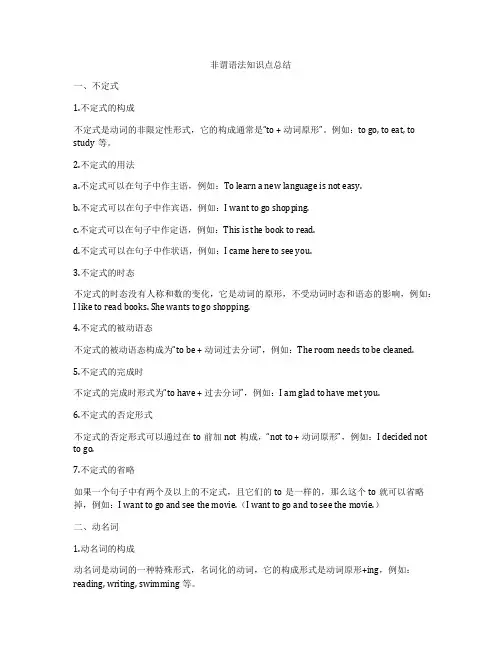
非谓语法知识点总结一、不定式1.不定式的构成不定式是动词的非限定性形式,它的构成通常是“to + 动词原形”。
例如:to go, to eat, to study等。
2.不定式的用法a.不定式可以在句子中作主语,例如:To learn a new language is not easy.b.不定式可以在句子中作宾语,例如:I want to go shopping.c.不定式可以在句子中作定语,例如:This is the book to read.d.不定式可以在句子中作状语,例如:I came here to see you.3.不定式的时态不定式的时态没有人称和数的变化,它是动词的原形,不受动词时态和语态的影响,例如:I like to read books. She wants to go shopping.4.不定式的被动语态不定式的被动语态构成为“to be + 动词过去分词”,例如:The room needs to be cleaned.5.不定式的完成时不定式的完成时形式为“to have + 过去分词”,例如:I am glad to have met you.6.不定式的否定形式不定式的否定形式可以通过在to前加not构成,“not to + 动词原形”,例如:I decided not to go.7.不定式的省略如果一个句子中有两个及以上的不定式,且它们的to是一样的,那么这个to就可以省略掉,例如:I want to go and see the movie.(I want to go and to see the movie.)二、动名词1.动名词的构成动名词是动词的一种特殊形式,名词化的动词,它的构成形式是动词原形+ing,例如:reading, writing, swimming等。
2.动名词的用法a.动名词可以在句子中作主语,例如:Swimming is my favorite sport.b.动名词可以在句子中作宾语,例如:I enjoy reading books.c.动名词可以在句子中作定语,例如:I saw a man running in the street.d.动名词可以在句子中作状语,例如:She left without saying goodbye.3.动名词的时态动名词的时态也是不受动词的时态和语态的限制,例如:I like swimming. She has been reading for an hour.4.动名词的被动语态动名词的被动语态构成为“being + 过去分词”,例如:Being loved by everyone makes her happy.5.动名词的否定形式动名词的否定形式是在-ing后面加not,例如:He avoids talking to her.6.动名词的所有格形式动名词的所有格形式是在-ing后面加‘s,例如:I don’t like his swimming in the pool.7.动名词与不定式的区别动名词和不定式在句子中有时候可以互换,但它们表示的含义和用法是有区别的。
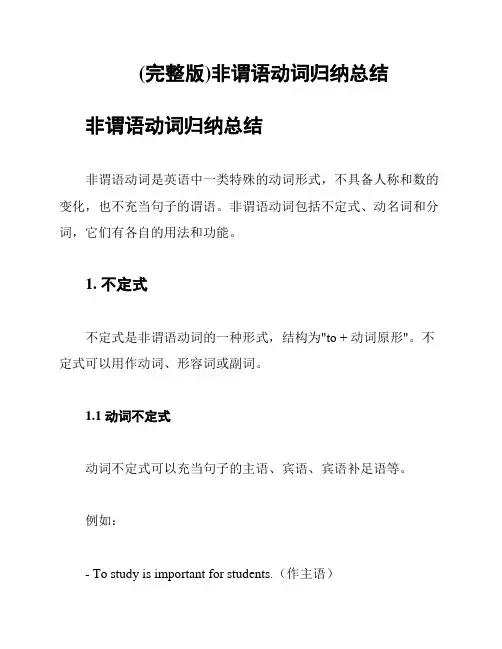
(完整版)非谓语动词归纳总结非谓语动词归纳总结非谓语动词是英语中一类特殊的动词形式,不具备人称和数的变化,也不充当句子的谓语。
非谓语动词包括不定式、动名词和分词,它们有各自的用法和功能。
1. 不定式不定式是非谓语动词的一种形式,结构为"to + 动词原形"。
不定式可以用作动词、形容词或副词。
1.1 动词不定式动词不定式可以充当句子的主语、宾语、宾语补足语等。
例如:- To study is important for students.(作主语)- I want to learn English.(作宾语)- She asked me to help her.(作宾语补足语)1.2 形容词不定式形容词不定式用于修饰名词或代词。
例如:- I have a book to read.(修饰名词)- He is the man to trust.(修饰代词)1.3 副词不定式副词不定式用于修饰动词、形容词或副词。
例如:- She worked hard to pass the exam.(修饰动词)- He is happy to see you.(修饰形容词)- She walked quickly to catch the bus.(修饰副词)2. 动名词动名词是非谓语动词的一种形式,结构为动词的现在分词形式。
动名词可以充当句子的主语、宾语、宾语补足语等。
例如:- Swimming is good exercise.(作主语)- I enjoy playing basketball.(作宾语)- She kept on talking.(作宾语补足语)3. 分词分词是非谓语动词的一种形式,根据时态和完成程度的不同,分词分为现在分词和过去分词。
3.1 现在分词现在分词用于表示主动或进行的动作。
例如:- The running boy is my brother.(作定语)- She stood there, crying.(作状语)3.2 过去分词过去分词用于表示被动或完成的动作。
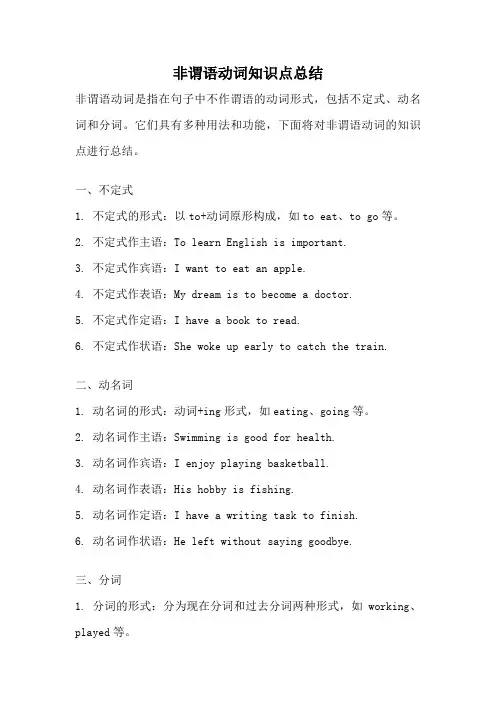
非谓语动词知识点总结非谓语动词是指在句子中不作谓语的动词形式,包括不定式、动名词和分词。
它们具有多种用法和功能,下面将对非谓语动词的知识点进行总结。
一、不定式1. 不定式的形式:以to+动词原形构成,如to eat、to go等。
2. 不定式作主语:To learn English is important.3. 不定式作宾语:I want to eat an apple.4. 不定式作表语:My dream is to become a doctor.5. 不定式作定语:I have a book to read.6. 不定式作状语:She woke up early to catch the train.二、动名词1. 动名词的形式:动词+ing形式,如eating、going等。
2. 动名词作主语:Swimming is good for health.3. 动名词作宾语:I enjoy playing basketball.4. 动名词作表语:His hobby is fishing.5. 动名词作定语:I have a writing task to finish.6. 动名词作状语:He left without saying goodbye.三、分词1. 分词的形式:分为现在分词和过去分词两种形式,如working、played等。
2. 现在分词作主语:Reading helps improve vocabulary.3. 现在分词作宾语:She heard someone calling her name.4. 现在分词作表语:He is a hardworking student.5. 现在分词作定语:I saw a running dog in the park.6. 现在分词作状语:He left the room, closing the door behind him.7. 过去分词作宾语补足语:I found the door closed.四、非谓语动词的逻辑主语1. 不定式的逻辑主语:It is important to learn English.2. 动名词的逻辑主语:Swimming helps improve health.3. 分词的逻辑主语:Reading books is beneficial for children.五、非谓语动词的否定形式1. 不定式的否定形式:not+不定式,如not to go、not to eat等。
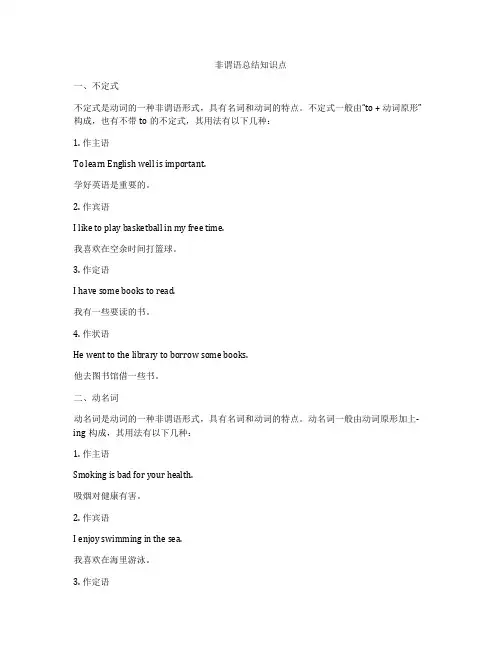
非谓语总结知识点一、不定式不定式是动词的一种非谓语形式,具有名词和动词的特点。
不定式一般由“to + 动词原形”构成,也有不带to的不定式,其用法有以下几种:1. 作主语To learn English well is important.学好英语是重要的。
2. 作宾语I like to play basketball in my free time.我喜欢在空余时间打篮球。
3. 作定语I have some books to read.我有一些要读的书。
4. 作状语He went to the library to borrow some books.他去图书馆借一些书。
二、动名词动名词是动词的一种非谓语形式,具有名词和动词的特点。
动名词一般由动词原形加上-ing构成,其用法有以下几种:1. 作主语Smoking is bad for your health.吸烟对健康有害。
2. 作宾语I enjoy swimming in the sea.我喜欢在海里游泳。
3. 作定语I need a book for writing.我需要一本写作用的书。
4. 作状语He left home without saying goodbye.他出门时没有说再见。
三、分词分词是动词的一种非谓语形式,具有形容词和副词的特点。
分词有现在分词和过去分词两种形式,其用法有以下几种:1. 现在分词作定语I saw a girl wearing a red dress.我看见一个穿红裙子的女孩。
2. 过去分词作定语The broken chair needs to be repaired.坏了的椅子需要修理。
3. 现在分词作状语Walking along the river, I felt relaxed.沿着河边走,我感到轻松。
4. 过去分词作状语Worried about her daughter, she couldn’t sleep well last night.担心女儿的她昨晚没睡好。
最全的非谓语动词知识点总结非谓语动词是指动词的非动词形式,分为动词不定式、动名词和现在分词、过去分词。
下面是非谓语动词的最全知识点总结:一、动词不定式(Infinitive)1.动词不定式的形式:- 常规形式:to+动词原形(to do)- 被动形式:to be done- 完成形式:to have done2.动词不定式的用法:- 作主语:To read books is my hobby.- 作宾语:I want to go home.- 作定语:Can you give me something to eat?- 作状语:I study hard to pass the exam.3.动词不定式与一些动词搭配:- 动词make, let, have, help后接动词原形作宾语:She made me clean the room.- 动词比如tell, ask, advise, want, expect后可接动词不定式作宾语补足语:She told me to go there.二、动名词(Gerund)1.动名词的形式:- 动词原形+ing(doing)2.动名词的用法:- 作主语:Swimming is good for health.- 作宾语:I enjoy reading books.- 作表语:His job is teaching English.- 作定语:The running water sounds relaxing.- 作状语:I walked home, singing songs.3.动名词与一些动词搭配:- 动词stop, finish, keep, mind后接动名词作宾语:He finished reading the book.- 动词enjoy, dislike, mind后接动名词作宾语:I enjoy swimming.三、现在分词(Present Participle)1.现在分词的形式:- 原形+ing(doing)2.现在分词的用法:- 作定语:The crying baby needs attention.- 作状语:He left the party, feeling disappointed.3.现在分词与一些动词搭配:- 动词keep, catch, find后接现在分词作宾补:I caught him stealing my money.- 动词see, hear, notice后接现在分词作宾补:I saw him walking in the park.四、过去分词(Past Participle)1.过去分词的形式:- 动词的过去分词形式(done)2.过去分词的用法:- 用于完成时态:I have finished my homework.- 用于被动语态:The book was written by him.3.过去分词与一些动词搭配:- 动词have, has, had, get, be等后接过去分词构成完成时态:He has eaten breakfast.- 动词make, let, have, get后接过去分词构成被动语态:She was made to clean the room.。
非谓语动词总结知识点非谓语动词是英语中非常重要的语法现象,它们包括不定式、动名词和分词。
非谓语动词在句子中不能独立作谓语,但可以充当其他成分,如主语、宾语、定语、补语或状语。
不定式(Infinitive)不定式通常表示动作的未完成性或一般性。
它由“to”加上动词原形构成,有时也可以不带“to”。
不定式可以表示目的、原因、结果或条件。
- 表示目的:He went to the library to read a book.- 表示原因:She is happy to see you.- 表示结果:To my surprise, he won the first prize.- 条件:If you study hard, you will pass the exam.动名词(Gerund)动名词是动词的-ing形式,它具有名词的特性,可以作主语、宾语或表语。
动名词通常表示正在进行的动作或习惯。
- 作主语:Swimming is good for health.- 作宾语:I enjoy reading.- 作表语:My hobby is collecting stamps.分词(Participle)分词有两种形式:现在分词和过去分词。
现在分词通常以-ing结尾,过去分词形式多样。
分词可以作定语、补语或状语。
- 现在分词作定语:The boy running in the park is my brother.- 过去分词作定语:The letter written by her was very touching. - 现在分词作补语:I found the book interesting.- 过去分词作补语:The room was cleaned by the maid.非谓语动词的时态和语态非谓语动词的时态和语态通过不同的形式表达。
现在分词表示进行或主动;过去分词表示完成或被动;不定式表示未完成或一般性。
常用非谓语用法大总结非谓语用法是指动词的非谓语形式(不带主语和谓语),包括不定式、动名词和现在分词、过去分词。
非谓语在句子中具有特定的功能和作用,可以作主语、宾语、状语等,能够丰富句子结构,增强表达的灵活性。
以下是常用的非谓语用法大总结:一、不定式用法:1.作主语:To love is to live.(爱即是生活。
)To err is human, to forgive divine.(人非圣贤,孰能无过。
)2.作宾语:I hope to see you.(我希望见到你。
)He wants to go shopping.(他想去购物。
)3.作表语:4.作宾补:They agreed to help us.(他们同意帮助我们。
)I want to eat some fruit.(我想吃些水果。
)5.作定语:I have a book to read.(我有一本书要读。
)This is the place to be.(这是最佳位置。
)6.作状语:She went to the store to buy some milk.(她去商店买牛奶。
)7.动词不定式的形式和功能:主动形式:to +动词原形被动形式:to be +过去分词8.一些常见的固定搭配:to be honest(老实说), to be frank(坦白说), to be fair (公平地说), to be sure(确切地说), to tell the truth(实话告诉你), etc.二、动名词用法:1.作主语:Smoking is harmful to health.(吸烟对健康有害。
)Learning is a lifelong process.(学习是一辈子的事。
)2.作宾语:I enjoy swimming.(我喜欢游泳。
)She suggested watching a movie.(她建议看电影。
)3.作表语:His hobby is playing basketball.(他的爱好是打篮球。
非谓语动词总结(高考完整版)一、非谓语动词的含义非谓语动词首先是一种动词形式,其次是这种动词形式不能做谓语,综合这两点,我们将其叫做非谓语动词。
老师进来时,她假装正在读书。
④完成时:to have done(表示主动和完成)eg: The thief is said to have escaped.据说小偷已经逃跑了。
⑤完成被动式:to have been done(表示被动和完成)eg:The thief is said to have been arrested.据说小偷已经被抓住了。
⑥完成进行式:to have been doing (表示主动和完成进行)eg: She is said to have been working in the factory over the last 20 years.据说在过去的20年里,她一直在这家工厂工作。
(2)动名词①基本形式:doing (表示主动)eg: Travelling in space by ordinary people will be common in the future.在未来,普通人在太空旅行将会是普遍的事情。
②被动式:being done(表示被动)eg: Freddy and his band could go nowhere without being followed by their fans.弗雷迪和他的乐队到哪里都被他们的粉丝跟着。
③完成式:having done(表示主动和完成)eg: I have no idea of his having done such a thing against you.我不知道他做过这样一件违背你的事情。
④完成被动式:having been done(表示被动和完成)eg: Many customers complain of having been given short weight at that shop.很多顾客抱怨在那家商店被缺斤少两过。
最全的非谓语动词知识点总结非谓语动词是指动词的非时态形式,它不具备时态和人称的变化。
常见的非谓语动词包括动词不定式、动名词和分词。
下面是非谓语动词的最全知识点总结:1. 动词不定式(to-不定式):-用法:- 作主语:To travel is my dream.- 作宾语:I want to go home.- 作定语:This is a book to read.- 作状语:He studies hard to pass the exam.- 不定式的否定形式:not + 不定式- 不定式的完成形式:to have + 过去分词- 不定式的被动形式:to be + 过去分词2. 动名词(-ing 形式):-用法:- 作主语:Swimming is good exercise.- 作宾语:I enjoy reading books.- 作表语:His favorite activity is playing soccer.- 作定语:I have a writing assignment.- 作状语:She left, crying.- 动名词的否定形式:not + 动名词-动名词可以表示一些动作、状态或者习惯性的行为3.分词:- 现在分词(-ing 形式):-用法:- 作定语:The running water is cold.- 作状语:He left, whistling a tune.-合并式现在分词:在主语和系动词之间发生合并,形成一个合并式的形容词。
- The girl is crying. (合并式:The girl is crying.)- 过去分词(一般以 -ed 或 -en 结尾):-用法:- 作定语:A broken window needs to be fixed.- 作状语:I was tired, so I went to bed.-分词作定语时,与被修饰词之间具有被动、完成、被完成等被动意义。
非谓语动词用法总结大全非谓语动词是历年的热点、难点和重点。
在学习非谓语动词时,好多同学感到剪不断,理还乱。
所以在复习中,特别有必要通过视察、比拟,归纳驾驭其用法,并总结其用法。
下面是学习啦我整理的非谓语动词用法总结大全,盼望对大家的英语学习有所协助。
最全面的非谓语动词用法总结1 .不定式和动名词作主语的区分(1)动名词作主语通常表示抽象动作;而不定式作主语表示详细动作。
Smoking is prohibited(制止)here.这里制止抽烟。
(抽象)It is not very good for you to smoke so much.你抽这么多烟对你身体很不好。
(详细)(2)动名词作主语时,通常用以表示一件确定的事或经历。
不定式短语通常用来表示一件未完成的事或目的。
Climbing mountains is interesting.爬山很好玩。
(经历)Driving a car during the rush hour is tiring.在顶峰时刻开车令人厌烦。
(经历)(3)不定式做主语,一般用it当形式主语,把作主语的不定式短语后置。
It took me only five minutes to finish the job.2 .不定式、动名词和分词作表语的区分(1)不定式作表语1)不定式作表语一般表示详细动作,特殊是表示将来的动作。
To do two things at a time is to do neither.--次做两件事等于未做。
What I would suggest is to start work at once.我的建议是马上起先干。
2)假如主语是不定式(表示条件),表语也是不定式(表示结果)。
To see is to believe.百闻不如一见。
To work means to earn a living.工作就是为了生活。
3)假如主语是以aim,duty,hope,idea,happiness,job,plan,problem,purpose,thing,wish等为中心的名词,或以what 引导的名词性从句,不定式作表语是对主语起补充说明作用。
非谓语动词经典总结一.动词不定式1. 不带to 的不定式:1)have/let/make sb. +do help sb. (to) do2) why not/ had better/ might as well +do3) see/ watch/ notice/ observe sb.+do/ doing4) have nothing to do but +do=have no choice/ alternative but +to doprefer to do rather than +do2. be said to bebe reported to + be doing(正在做…)be considered to have done(已做过…)be believed to3. 主动形式表被动意义的不定式:The young man is easy to get along with.I have a lot of homework to do.The plan is too difficult to carry out.He made his lessons easy to understand.We find the problem difficult to settled.4. 固定搭配t he first /last to do… expect there to be…get s b. to do… promise to do…refuse to do… offer to do…ma nage to do… afford to do…pretend to do…as if to do sth二、动名词:1.构成:(not) doing/ being done2._______(expose) to sunlight for a long time will do harm to your skin.(作主语)I can’t stand ________(tease) in public. (作宾语)3. 固定搭配:1)It’s no good/use doing…/ There is no point in doing…2) have some trouble/difficulty in doing…have fun doing…/ spend(waste) time in doing…3) the key to / the approach to / be used tobe vital to / be limited to / get down toon one’s way to / when it comes to / look forward toadapt to / devote oneself to4) prevent/stop/forbid/ban/keep sb. from doing…5)sth. want /need /require doing…be worth doing…/ can’t help doing…6) resist (抵制)insist on tolerate/stand / bear/put up with(忍受)avoid (避免) / delay(推迟) / imagine / mind / miss / escape enjoy / appreciate / risk (冒险)/quit / suggest dong…4. re member to do/ doing… forget to do/ doing…regret to do (很遗憾地要做…) / regret doing…(后悔做过…)try to do/ doing… mean to do/ doing…stop to do/ doing…5. allow / permit doing…注意:allow/ advise/ permit/ forbid sb. to do…三、现在分词构成:(not)doing/ having done1.悬垂分词:generally speaking / Judging by(from)considering that / seeing that / given that…(鉴于、考虑到)to be honest / to tell the truth / to make things worsecompared to(with) /provided that(假如)…________(consider) his age, he did it well.Considering he’s only been learning English for a year, he speaks it very well. 2. There is a notice in the park _________(say),“Keep off the grass.”A letter/ a sign/ a note/ a message/ a tomb _________(read)….3. _________(taste) delicious, the food sells well.Sound/ smell/ look/ taste/feel +adj.4.He made some comments ___(concern) pollution.(regard/include)This is an accident __________(involve) a group of youthsThere are a group of youths ______(involve) in the accident.5.不及物动词常用doing :1) the ________(rise) price / with the price ______(rise)a boy with his hand _________(raise)2) prevent the mistake from _________(occur发生)prevent the mistake from _______(make)3) I met a man __________(wander) in the street.4) There are some problems __________(remain) unsettled.5) I found an injured man _________(lie) on the ground.6) It is a team _________(consist) of ten players.8. doing与having done的区别:having done 所表示的动作在谓语的动作之前发生1) China joined the WTO, ________(make) it develop quickly in economy.2) The storm left,_________(cause) a lot of damage to the villages.3)Many early Europeans, _________(believe) the earth to be flat, feared that Columbus would fall off the edge of the earth.4)_____________(show) around the Bird’s Nest, tourists were then taken to visit the Water Cube.四、过去分词:(-ed)1. done / to be done(将来的被动)/ being done(正在的被动)a party __________(hold) tomorrowa party _________ nowa party _________ yesterday2. be dressed in… / be seated… / be occupied with…be lost in thought / be absorbed in… /be devoted to…be caught in… / be stuck in… / be buried in…be well prepared for…/be delighted to do… / be convinced of…3. a ___________(disappoint) voice/ expression/ tears/ smilean __________(excite) look in a __________(tremble) voicehave the security ________(break) intohave the bike _________(repair)have his house _________(destroy)4.1)see the plan __________(carry) out2) hear the song _________(sing)3) make himself _________(understand)4) keep me _________(remind) of the past5)keep me __________(inform) of what is going on abroad6)keep his eyes _________(fix) on the book五.独立主格结构以及with +n. + doing/ to do/ done/ adj./ 介词短语两个考点1)Weather __________(permit), we’ll have a picnic tomorrow.2)There ________(be) no buses, we had to walk home.3)With the magazines __________(buy), I left the post office.4)With time _______(go) by, I forgot the unpleasant experience.5)He went to the cave with the candle _________(burn).6)make the customers ___________(convince) of the quality of the products六.判断逻辑主语是否一致:1)Written in a hurry, ____________.A. they found many mistakes in the report.B. there are many mistakes.C. Sam made so many mistakes.D. the report is full of mistakes.。